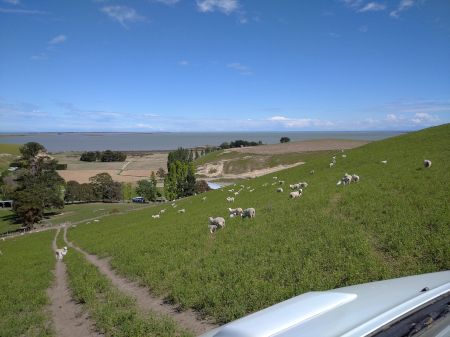The “Hill Country Futures” research programme (BLNZT1701) is funded by Beef + Lamb New Zealand, MBIE, Seed Force New Zealand and PGG Wrightson Seeds.
The Dryland Pastures Research Group, and On-Farm Research (https://on-farmresearch.co.nz/) are currently contributing to “Regenerating Hill Country Landscapes” theme of the Hill Country Futures programme (https://www.hillcountryfutures.co.nz/). Specifically, we are working on:
- Research Aim 2.1: Modelling forage legume yield nationally (Lucerne proof of concept),
- Research Aim 3.1: Desktop analysis of plants for the landscape and
- Research Aim 3.2: Evaluation of legumes in different environments.
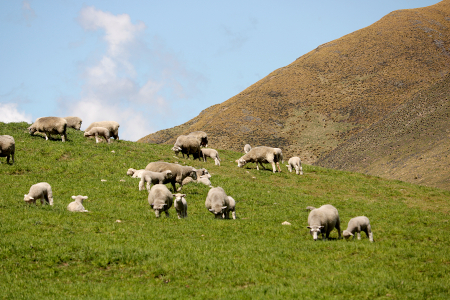


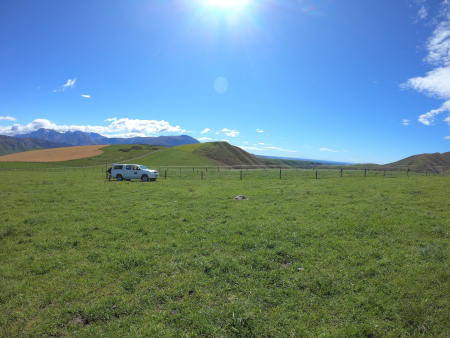

Development of lucerne yield and suitability maps for New Zealand (RA 2.1)
The APSIM Next Generation model was used by the Lincoln based Plant & Food Research and Landcare Research modelling teams to develop a nationwide lucerne yield map. Yield simulations were at 5 km resolution in response to 30 years of historical weather data to determine areas suitable for growing lucerne (Teixeira et al. 2020). Subsequently, annual shoot DM yield were estimated for both rainfed and irrigated soil moisture conditions.
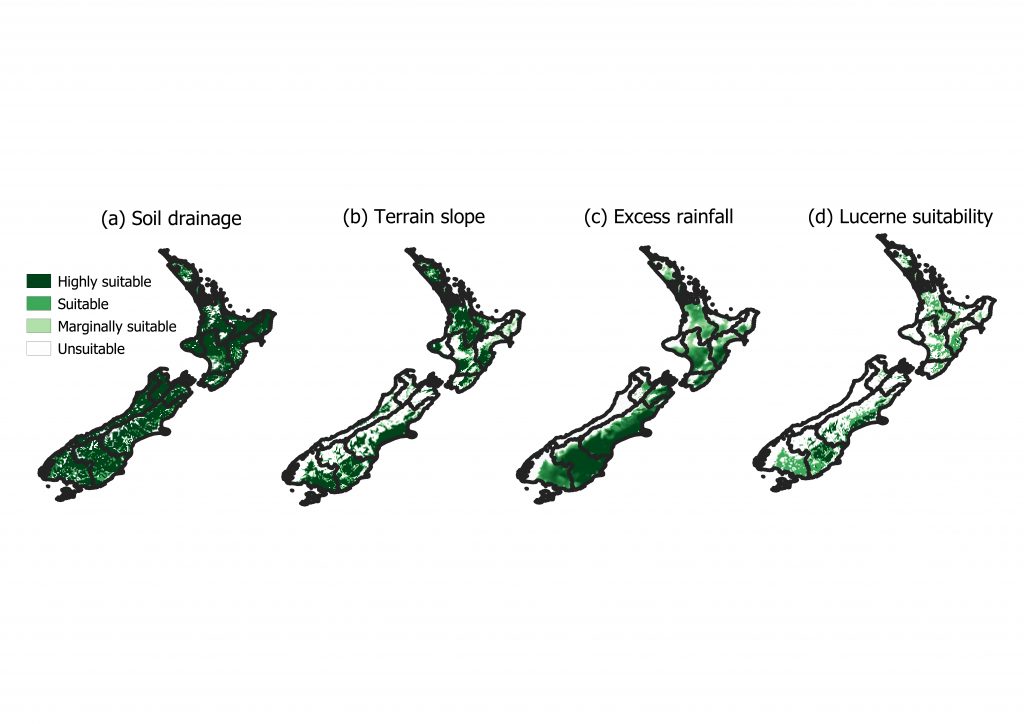

The AgYields National Database (RA 3.1)
A spin-off from this programme has been the development of the AgYields National Database, which is a national repository of crop and pasture yield data collected by staff, students and researchers at universities, crown research institutes, industry organisations and commercial businesses throughout New Zealand.
This open access database provides long-term storage and security for pasture and crop growth data, which would otherwise be lost over time. Researchers are encouraged to deposit their data by creating an account here: https://www.agyields.co.nz/home
Further information can be found here: https://www.hillcountryfutures.co.nz/resources/beef-and-lamb-knowledge-hub
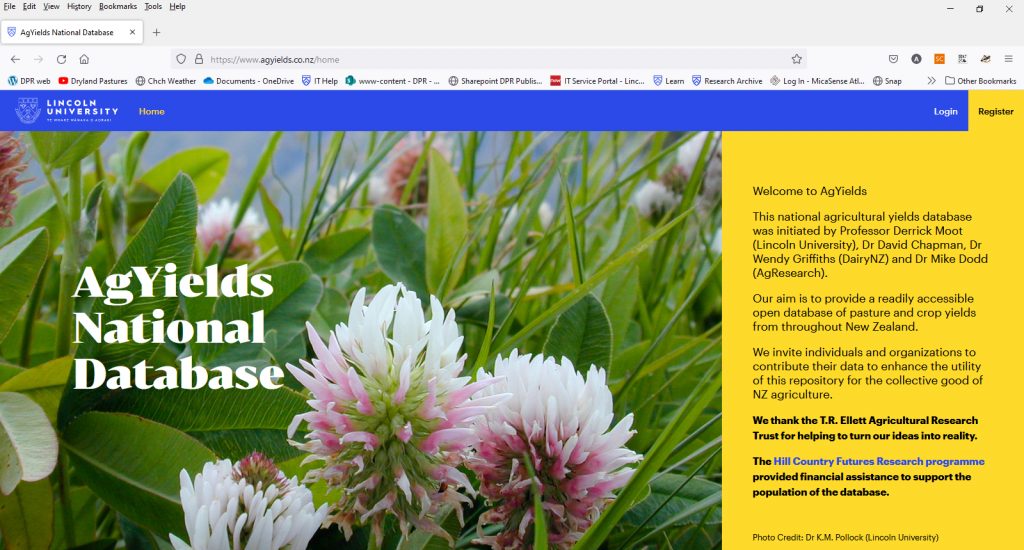
Legumes in different environments (RA 3.2)
For Research Aim 3.1 the DPR Group is also working with On-Farm Research in the North Island to collect and collate yield and quality data for a range of pasture species and mixtures throughout New Zealand. In addition, we are collecting a range of on-site data to quantify the environment at the sites.
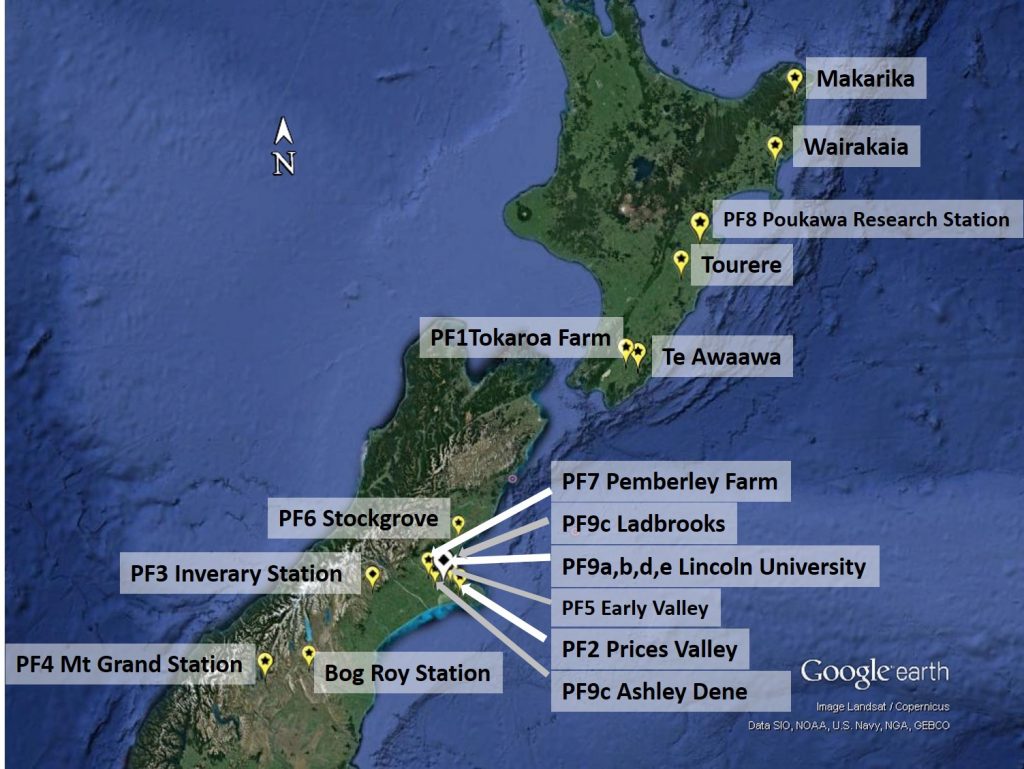
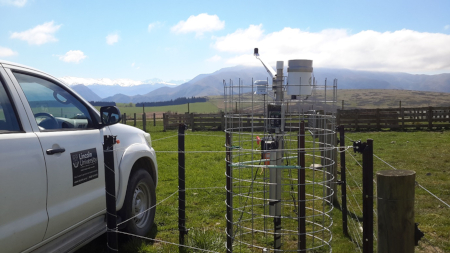
Researchers
- Derrick Moot, Head of Dryland Pastures Research
- Alistair Black, Senior Lecturer
- Malcolm Smith, Research Technician
- Jason Nolan, Research Technician
- Sonya Olykan, Research Officer
- Annamaria Mills, Research Officer
- Carmen Teixeira, Postdoctoral Fellow
- Paul Muir, Managing Director/Senior Researcher, On-Farm Research
- Edmar Teixeria, Senior Scientist, Plant & Food Research
- Jing Guo, GIS Spatial Modeller – Infomatics, Manaaki Whenua – Landcare Research
Students
- Laura Keenan PhD
- Arulmageswaran (Arul) Shampasivam PhD
- Thinzar Soe Myint PhD
- Sarah Hoppen PhD (2022)
- Marcus Talamini Jr. PhD (2022)
- Alec Wills, B.Ag.Sci (Hons) 2022
- Jian (Frank) Liu M.Ag.Sci 2021
- Jacob Babington B.Ag.Sci (Hons) 2020
- Stuart Hunter B.Ag.Sci (Hons) 2020
- Eve Thomas B.Ag.Sci (Hons) 2020
- Xiumei Yang PhD 2020
- Zac Averill B.Ag.Sci. (Hons) 2019
B+LNZ Factsheets
Our research has been used to prepare these factsheets, available from the Beef + Lamb New Zealand Knowledge Hub, and summarise our field research into “farm ready” messages to help with management and planning:
Pasture and animal production
- Animal production from annual clover/plantain based pastures
- Lucerne establishment (spring): Weed control options
- Lucerne: Winter weed control options
- Production and persistence of dryland pastures
- Explaining pasture water use
- Pasture mixes for dryland farming systems
- Liveweight production of sheep grazing dryland pastures
- Hill Country Futures: AgYields national database
- Subterranean clover tolerance to waterlogging
- Broadleaf weed control in emerging subterranean clover
Soils
- Hill Country Futures: Calcium and magnesium requirements
- Hill Country Futures: Aluminium toxicity
- Hill Country Futures: Nutrient and lime requirements of lucerne
- Hill Country Futures: Fertiliser and lime strategies
- Hill Country Futures: Lime use
- Hill Country Futures: Nitrogen fertiliser use
- Hill Country Futures: Phosphorus requirements
- Hill Country Futures: Potassium requirements
- Hill Country Futures: Nutrient and lime requirements for red and white clover swards
- Hill Country Futures: Soil and pasture testing protocols
- Hill Country Futures: Sulphur requirements
- Hill Country Futures: Trace element requirements
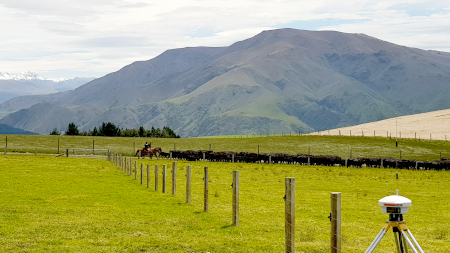

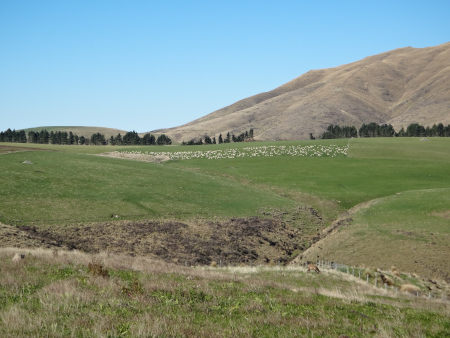
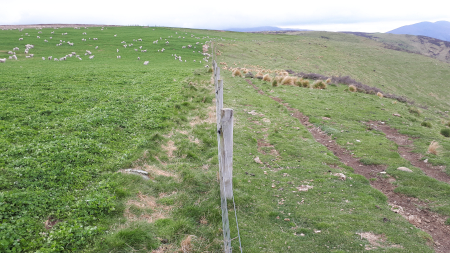
Journal Publications
- Plant diversity with species drilled in the same or alternate rows enhanced pasture yield and quality over 4 years. Resilient Pastures – Grassland Research and Practice Series 17: 263-274.
- Black AD. 2021. Pasture science informs seed mixture decisions for simple and multi-species swards. The Journal 25(4): 12-17.
- Burrows E, Mills A, Dash D, Jack D, Andrews M, Black AD. 2021. Nitrate effects on N2 fixation, growth and feed quality of lucerne and perennial lupin. Journal of New Zealand Grasslands 83: 79-82.
- Chapman J, Smith M, Lucas RJ, Moot DJ. 2021. Legumes are the key to increasing productivity at ‘Inverary’ a summer moist hill/high country farm in mid-Canterbury. Journal of New Zealand Grasslands 83: 51-58.
- Guo J, Teixeira CSP, Barringer J, Hampton JG, Moot DJ. 2022. Estimation of time to key phenological stages to guide management of subterranean clover (Trifolium subterraneum L.) in New Zealand. European Journal of Agronomy 134: 126451.
- Mills A, Smith MC, Moot DJ. 2019. Relationships between sheep liveweight production and dry matter yield for lucerne-based pastures in spring. Journal of New Zealand Grasslands 81: 69-74.
- Mills A, Thomson BC, Muir PD, Smith NB, Moot DJ. 2021. Resident hill country pasture production in response to temperature and soil moisture over 20 years in Central Hawke’s Bay. Resilient Pastures Symposium – Grassland Research & Practice Series 17: 253-263. Supplementary material (Mean daily growth rates over 20 years): https://www.nzgajournal.org.nz/index.php/rps/article/view/3451/3153
- Moot DJ, Anderson PVA., Anderson LJ, Anderson DK. 2019. Animal performance changes over 11 years after implementing a lucerne grazing system on Bog Roy Station. Journal of New Zealand Grasslands 81: 75-80.
- Moot DJ, Black AD, Lyons EM, Egan LM, Hofmann RW. 2021. Pasture resilience reflects changes in root and shoot responses to defoliation, water and nitrogen. Resilient Pastures – Grassland Research and Practice Series 17: 71-80.
- Moot DJ, Black AD, Mills A. 2020. New Zealand drivers of pasture production and options available to improve composition and management. In: Growing with Grasslands. Proceedings of the 61st Annual Virtual Conference of the Grassland Society of Southern Australia held online 22 July to 19 August 2020. p 50-54.
- Moot DJ, Black AD. Dec 2020. Grazing management for pasture resilience. AgScience, Issue 57 (Special Issue on Regenerative Agriculture). p 12-13.
- Moot DJ, Davison R. 2021. Changes in New Zealand red meat production over the past 30 yr. Animal Frontiers 11: 26-31.
- Moot DJ, Griffiths WM, D.F. C, Dodd MB, Teixeira CSP. 2021. AgYields – a national database for collation of past, present and future pasture and crop yield data. Journal of New Zealand Grasslands 83: 15-24.
- Moot DJ, Smith M., Mills A. 2020. Liveweight production, dry matter yield and seasonal composition from dryland lucerne and lucerne/grass mixes over five years. New Zealand Journal of Agricultural Research 63: 272-301.
- Moot DJ, Yang X, Ta HT, Brown HE, Teixeira EI, Sim RE, Mills A. 2020. Simplified methods for on-farm prediction of yield potential of grazed lucerne crops in New Zealand. New Zealand Journal of Agricultural Research 65: 252-270.
- Morton J, Moot DJ, Moir JL. 2021. A summary of research results on pasture production responses to fertiliser and lime in the South Island hill and high country. Journal of New Zealand Grasslands 83: 35-42.
- The performance and profitability of plantain in East Coast farming systems: a modelling approach. Journal of New Zealand Grasslands. 81: 81-86.
- Muir PD, Thomson BC, Smith NB. 2020. Effect of cultivar, time of establishment and cutting interval on yield and seed set of arrowleaf clover. Journal of New Zealand Grasslands 82: 89-94.
- Myint TS, Black AD, Moot DJ. 2021. Nitrogen effects on species’ contributions to grazed pasture mixtures under high loss and application restrictions. Journal of New Zealand Grasslands83: 25-34.
- Myint TS, Wood L, Black AD. 2019. Optimisation of perennial ryegrass, white clover and plantain mixtures for maximum dry matter yield in an intensive pasture system. Presented at: In: Cells to Satellites. Proceedings of the 2019 Agronomy Australia Conference, 25 – 29 August 2019. Wagga Wagga, Australia.
- Olykan ST, Lucas RJ, Black AD, Moot DJ. 2021. Refining foliage sampling protocols for white clover. Journal of New Zealand Grasslands 83: 59-68.
- Olykan ST, Lucas RJ, Hunter SR, Moot DJ. 2021. Growth rates and persistence of annual and perennial clover. Journal of New Zealand Grasslands 83: 69-78.
- Olykan ST, Lucas RJ, Moot D.J. 2019. Sampling methods for clover species in grazed pastures to diagnose mineral deficiencies. Journal of New Zealand Grasslands 81, 241-248.
- Olykan ST, Lucas RJ, Nicholson DJ, Doscher C, Moot DJ 2019. Maximising the subterranean clover content on a summer dry Wairarapa hill country farm through grazing management. Journal of New Zealand Grasslands 81: 91-100.
- Sim RE, Moot DJ 2019. The influence of spring grazing management on yield and water use of rainfed lucerne. Journal of New Zealand Grasslands 81: 187-194.
- Spall J, Ogle GI, Muir PD. (2019). Evaluating the benefits of mixed plantain/chicory/clover pastures in a Hawkes Bay sheep breeding and finishing farm. Journal of New Zealand Grasslands 81: 35-38.
- Ta HT, Teixeira EI, Brown HE, Moot DJ. 2020. Yield and quality changes of different fall dormancy rating under three defoliation regimes. European Journal of Agronomy 115: 126012.
- Talamini Jr. MV, Sharifiamini S, David E, Pollock KM, Mills A, Moot DJ. 2021. Pasture persistence of four grasses under different nitrogen regimes in a summer dry environment. Resilient Pastures – Grassland Research and Practice Series 17: 307-320.
- Taylor BJO, Hofmann RW, Moot DJ. 2020. Yield of subterranean clover after post-emergence herbicide application for broadleaf weed control. Journal of New Zealand Grasslands 82: 121-128.
- Taylor BTO, Mills A, Smith MC, Lucas RJ, Moot DJ. 2021. Yield and botanical composition of four dryland pastures at Ashley Dene Research Farm over 8 years. Resilient Pastures – Grassland Research and Practice Series 17: 275-284.
- Teixeira CSP, Hampton JG, Moot DJ 2020a. A code and descriptive scale for the phenological phases of subterranean clover (Trifolium subterraneum L). In: European Society of Agronomy, Seville: European Society of Agronomy.
- Teixeira CSP, Hampton JG, Moot DJ. 2020. Reproductive development in subterranean clover (Trifolium subterraneum L.): A reanalysis of Oceania datasets. European Journal of Agronomy 119: 126123.
- Teixeira CSP, Hampton JG, Moot DJ. 2020. Thermal time requirements for germination of four subterranean clover cultivars. New Zealand Journal of Agricultural Research 63: 301-314.
- Teixeira CSP, Hampton JG, Moot DJ. 2020b. Phenology of subterranean clover affected by sowing date. In: European Society of Agronomy, Seville: European Society of Agronomy.
- Teixeira CSP, Hampton JG, Moot DJ. 2021. Phenological development of subterranean clover cultivars under contrasting environments. Annals of Applied Biology 179: 246-258.
- Teixeira CSP, Hampton JG, Moot DJ. 2021. Time of sowing and cultivar effects on hardseededness and germination of subterranean clover seeds. New Zealand Journal of Agricultural Research 65: 309-333.
- Teixeira CSP, Lucas RJ, Olykan ST, Moot DJ. 2020. Causes of leaf reddening in subterranean clover cultivars. New Zealand Journal of Agricultural Research 63: 315-331.
- Teixeira CSP, Olykan ST, Lucas RJ, Moot DJ. 2022. Subterranean clover flowering time in New Zealand. Presented at: System Solutions for Complex Problems. Proceedings of the 20th Agronomy Australia Conference. Toowoomba, Australia.
- Teixeira E, Ausseil AG, Burgueño E, Brown H, Cichota R, Davy M, Ewert F, Guo J, Holmes A, Holzworth D, Hu W, de Ruiter J, Hume E, Jesson L, Johnstone P, Powell J, Kersebaum KC, Kong H, Liu J, Lilburne L, Meiyalaghan S, Storey R, Richards K, Tait A, van der Weerden T. 2020. A spatial analysis framework to assess responses of agricultural landscapes to climates and soils at regional scale. In: Mirschel W, Terleev VV, Wenkel K-O Eds. Landscape Modelling and Decision Support. Cham: Springer International Publishing. pp. 495-508.
- Yang X, Brown HE, Teixeira EI, Moot DJ. 2021. Development of a lucerne model in APSIM next generation: 1 phenology and morphology of genotypes with different fall dormancies. European Journal of Agronomy 130: 126372.
Thesis/Dissertations
- Lui J. 2021. Modelling approaches for lucerne growth and development under dryland conditions. M.Ag.Sci. thesis, Lincoln University. 165 p.
- Talamini MV. 2022. Understanding the physiology and agronomic performance of four perennial grass species under different nitrogen and water conditions in New Zealand drylands. PhD thesis, Lincoln University. 298 p.
- Willis AP. 2022. Growth and development of three subterranean clover cultivars and their tolerance of herbicide application. B.Ag.Sci dissertation, Lincoln University. 98 p.
- Babington, J. 2020. Pasture yield and quality responses to plant diversity from the second year of a multi-species mixture experiment. B.Ag.Sci. Hons dissertation. Lincoln University. 71 p.
- Hunter S. 2020. Annual clover herbage production. B.Ag.Sci. Hons dissertation. Lincoln University. 78 p.
- Thomas E. 2020. Long-term decline of sown species in two dryland subterranean clover-based pastures. B.Ag.Sci. Hons dissertation. Lincoln University. 62 p.
- Yang X. 2020. Modelling phenological development, yield and quality of lucerne (Medicago sativa L.) using APSIM next generation. PhD thesis, Lincoln University. 287 p. Online:
- Averill Z. 2019. Legume response to fertiliser application. B.Ag.Sci. Hons dissertation. Lincoln University. 99 p.
